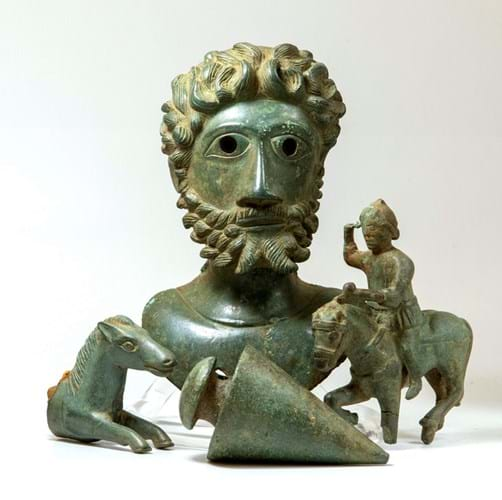
The Ryedale Hoard was discovered in North Yorkshire in 2020 and as the bronzes did not fall under the Treasure Act at the time they were sold at auction at Hansons to dealership David Aaron. However, later, an agreement to sell the group to the Yorkshire Museum was made possible with funding from US donor Richard Beleson (alongside support from the Art Fund and a number of individual donors) in 2021.
Image: Hansons.
Currently only objects that are at least 300 years old and made substantially of gold or silver, or which are found with artefacts of precious metals, can be declared ‘treasure’ which then enables museums to have first refusal.
Under the additional definition it will include those items deemed of ‘exceptional significance’ which are more than 200 years old and containing any metal.
As reported in ATG No 2378, the decision to widen the law’s scope followed the discovery of a number of important finds that fell outside the act such as The Crosby Garrett Roman parade helmet. It was discovered by a metal detectorist in 2010 and offered at Christie’s where a private buyer outbid several museums buying it for a hammer price of £2m.
The Treasure Act, which came into force in 1996, applies in England, Wales and Northern Ireland. Under the act, treasure is owned by the Crown when found and a person who finds an object believed to be treasure must notify the relevant authorities within 14 days.
Discoveries of treasure are assessed by a coroner, valued by a panel of experts, and then museums are given the chance to raise funds.
Protecting treasure discoveries
Arts and heritage minister Lord Parkinson of Whitley Bay said: “There has been a huge surge in the number of detectorists – thanks in part to a range of TV programmes – and we want to ensure that new treasure discoveries are protected so everyone can enjoy them.
“We are changing the law so that more artefacts uncovered by archaeologists and members of the public can go on display in museums rather than ending up in private hands. This will make sure they can be studied, admired and enjoyed by future generations.”
The statutory instrument to widen the definition was laid in parliament on February 20 and details of the operation of the Treasure Act and its administration will be outlined in parliament on February 23. Once the changes are debated and approved in parliament they are expected to come into force four months after signing.
According to the latest Treasure Annual Report and the Portable Antiquities Scheme (PAS) Annual Report, metal detectorists found 96% of archaeological and Treasure finds.
Alan Tamblyn, general secretary of the National Council for Metal Detecting (NCMD), said: “NCMD supports the increased legal protection. We also welcome the proposed improvements to the smooth running of the Treasure process.”





